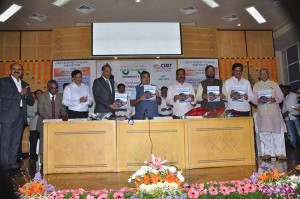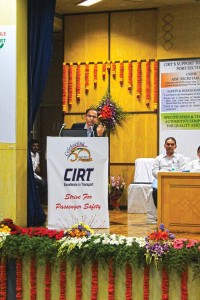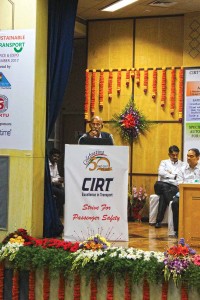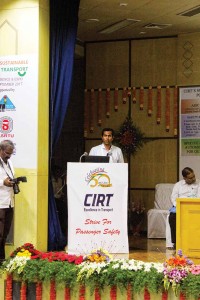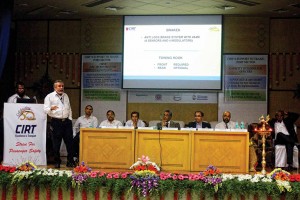A conference on ‘safe and sustainable public transport’ by the Central Institute of Road Transport (CIRT) reflected upon its fifty years journey.
Story & Photos: Ashish Bhatia
Celebrating fifty years of its journey in pursuit of transport efficiency and excellence, the Central Institute of Road Transport (CIRT) organised a conference, ‘Safe & Sustainable Public Transport’ on September 08, 2017, at its sprawling campus in Pune. Delving upon global best practices that can be implemented in India, public transport safety norms, sustainability challenges and solutions, and green fuel vehicle technology and mobility, the conference saw the stakeholders of State Transport Undertakings congregate at the CIRT campus. In his welcome address, Dr. R B Saner-Patil, Director, CIRT expressed that CIRT’s road map has always been progressive. “We have achieved excellent footprint in consultancy, training, component testing, and more, as part of the Central Motor Vehicle Rules (CMVR), and will continue to play a pivotal role,” he mentioned.
A joint initiative of the Ministry of Shipping & Transport, and the Association of State Road Transport Undertakings, CIRT was established in 1967. Helping the transport sector to attain high efficiency and productivity levels, CIRT has been offering technical training, consultancy and automobile component testing services to STUs, component manufacturers and automotive OEMs for the last 45 years. Instrumental in developing an automated vehicle fitness testing module and an automated driver license issuing module (called the Institute of Driving Training & Research), which could be replicated across regions and through out the country, CIRT also works as a test agency (CMVR 124 & 126) authorised by the Ministry of Road Transport (MoRTH). Accredited by the National Board of Testing and Calibration Laboratories (NABL), and by the Bureau of Indian Standards Recognition, CIRT has come to have testing laboratories. It has gained an ability to carry out feasibility studies for public transport systems, BRTS, metro bus system, toll plazas, automated border check posts and driving test tracks.
Focusing on public transport
Revealing in his inaugural speech that the Central Government has decided to provide a strong push to the public transport, Union Minister for road transport and highways Nitin Gadkari said that a change in the mindset to be able to address issues like traffic, pollution and accidents is necessary. Stating that the growth of private vehicles is exerting pressure for the expansion of existing national highways by one lane every three years, which is not feasible, expressed Gadkari. He expressed, “Enhancing public transport is our foremost priority.” Stressing on a complete transition to electric and alternate fuels like ethanol, methanol and Compressed Natural Gas (CNG), Gadkari mentioned, “At a time when the government is moving to BSVI compliant fuel, there are those who are hesitating to shift.” Citing public transportation as a priority, Gadkari said that his ministry is focusing on the operation of buses, taxis and two-wheelers on electricity. Stating that the use of alternative fuels will provide boost to the agricultural sector, Gadkari expressed the need to transform bus depots into bus ports. Urging state governments to make land available, he spoke about a plan to constitute district-level committees under the chairmanship of the collector to monitor road security, identify black spots and suggest road security measures by submitting a report of their findings to the state and central government.
Bus performance
Putting the blame on alternative energy sources for rising energy consumption, M Ravindra, Executive Director (Engg & IT), Telangana State Road Transport Corporation, in the first technical session of the day, expressed that greenhouse gases are responsible for the greenhouse effect, which ultimately leads to global warming. Stating that India ranks sixth globally in terms of energy demands, Ravindra averred, “Domestic crude oils are able to satisfy only a fourth of the total demand.” Advocating the use of alcohol based fuels, vegetable oil, Liquefied Natural Gas (LNG), Compressed Natural Gas (CNG) and bio-fuels among other alternate fuel sources, Ravindra drew attention to the Telangana State Road Transport Corporation (TRSTC) using 10 per cent bio-fuel blended diesel at 36 depots. “The plan is to extend its use to the remaining 60 depots,” he said.
On the use of 130 CNG buses by TSRTC, Ravindra opined that a CO2 reduction of around 2111-tonnes per annum has been achieved. Revealing that the blending of 10 per cent bio-fuel in diesel has led to a reduction of 8885-tonnes per annum CO2 emissions, Ravindra stated that the cost advantage is expected to be to the tune of Rs.15.75 crore. Touching upon the space consumed by CNG storage cylinders and the higher acquisition cost when compared to a diesel vehicle, Ravindra commented that TSRTC is looking at increasing its fleet of alternate fuel vehicles. Drawing attention to TSRTC availing a grant of Rupees-three lakh to convert existing diesel buses to CNG, Ravindra informed that the state government, in principal, has agreed to wave off MV Tax for electric vehicles.
Electric vehicle technology
Stressing upon the need to adopt a combination of fuel and technologies to limit CO2 emissions, Sanjay Bhatia, DGM Marketing, Tata Motors, said that electric buses as a sustainable transport solution are not profitable yet. He stated that the costs could be brought down by buses with a lower operating range, Bhatia mentioned, “The opportunity to lower pollution, lower NVH levels and increase reliability are hampered by the lack of infrastructure.” Drawing attention to the 12 m electric city bus displayed by Tata Motors at the event, Bhatia said that it will be made available in the fourth quarter of this year and is aimed at BRTS operations. Bhatia also touched upon LNG as an alternate fuel. He expressed that it supports higher payload, has a superior operating range, enables faster fuel refills, and presents superior refinement. The total capacity of LNG, said Bhatia, is estimated to reach 86.5 million tonnes per annum in FY2021-22. It is currently at the 6.5 million tonnes per annum level.
Safety and efficiency
Expressing that fares have largely remains stagnant despite the rise in input costs of STUs,
S Balachandran, Vice President (Vehicle Control Systems), Wabco, said that even a minor accident gives rise to a huge compensation burden. Stating that buses accounted for nine-per cent of the 31 per cent accidents recorded, involving trucks, buses and multi-axle vehicles, Balachandran averred that the reasons include loss of control, collision and lane departure. “This,” said Balachandran, “calls for the adoption of safety features.” We fought with OEMs for 15 years in India for the introduction of ABS, mentioned Bhatia. Citing the need to frugally engineer technologies in India, Balachandran expressed the need to incorporate technologies like ‘Tailguard’, ‘ESCsmart’, ‘OnGuard’ and ‘OnLane’. If the OEMs were willing to take the plunge, these technologies can be integrated at the cost of Rupees-one lakh per chassis opined Balachandran.
In his keynote address, Ashu Mahajan, DGM (Marketing), Allison Transmission, mentioned that an auto transmission system does not interrupt power during shifts and eliminates issues like clutch wear and replacement, and faster wear and tear of driveline components. Offering high tractive effort spread, and the ability to use full engine torque to tackle steep gradients, Mahajan said that their auto transmissions assure higher productivity and low cost of ownership. Possible to retrofit, the transmissions Allison offers, opined Mahajan, improve safety as driver can concentrate on driving. Drawing attention to the ‘Bus Systems’ survey, which samples 24 countries, 70 authorities and operators running 68500 buses, Atulkumar Katti, Director (Product Development), Volvo Group India Pvt. Ltd., said that future trends suggest a move to hybrid vehicles followed by electric, diesel, bio-diesel and CNG. Mentioned Katti, “Hybrids have attained a majority with electric propulsion systems a distant second. Plug-ins are at number three, and followed by trolley and fuel cell.” Citing Volvo’s strategy to offer a complete system that includes buses, infrastructure and services, battery charging on kilometre basis, and a competitive life cycle cost in comparison to diesel, Katti commented, “Open interfaces form the third cornerstone of Volvo for charging infrastructure and enable buses from other suppliers and driving standardisation together with partners like Siemens & ABB.”
Touching upon the need for charging terminals that offer a charging capacity of six minutes per 300kW for a 76 kWh charge, Katti said that manufacturers are looking to offer smaller battery packs that could be charged more frequently. “Not only will this help to light weight, it would also help to attain higher efficiency,” he averred. Claiming that the two hybrid buses sold to Navi Mumbai Municipal Transport under the FAME scheme have achieved 30 per cent fuel economy, Katti opined, “The need is to look at tropical climate conditions, traffic patterns, society and economic environment, electrification, demand and scale.”
The right chassis
Stating that the procurement of chassis is a big task for a STU, S H Ali, Scientist, CIRT, said that representatives are not even aware of wheelbase options the OEM has to offer. “A whopping 48 wheelbases are available across bus segments today,” he mentioned. Expressing disappointment over buses built on a truck chassis, Ali averred, “STU fleets use the maximum permitted (60 per cent) rear overhang without taking into account the overall length of the vehicle, which is twice that of the wheel base.” He urged STUs to look in detail at the location of the engine (forward or rear), and if the exhaust aftertreatment system is EGR or SCR based. “STUs should look at the manufacturing date of tyres, battery packs, brakes, seating and gangway layouts. A mandate for gearless automatic transmission should be passed,” said Ali. The chairman and managing director of Pune Mahanagar Parivahan Mahamandal Ltd. (PMPML), Tukaram Mundhe, expressed a need for STUs to outline issues affecting their performances. “STUs should change their approach. They should take into account the need to change their approach over providing buses to passengers as well as enable transportation access through public transport,” he said. Stating that STUs should use information technology as an enabler, Mundhe explained, “The need is to make the operations sustainable.”He opined, “There is the need to create a pull; to plan, to maintain and to implement.” “Apart from the need to create an effective framework, care should be taken while purchasing spares,” he remarked. Expressing that governance does not come from increasing layers, but through effective management, Mundhe called for drastic measures to stem the decline of STUs like optimal fleet utilisation, data based route rationalisation.
“There is a need to maintain breakdowns at one per cent, or less,” he averred.



